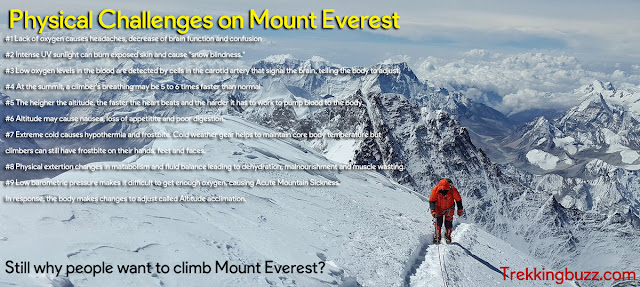Physical Challenges on Mount Everest
#1 Lack of oxygen causes headaches, decrease of brain function and confusion
#2 Intense UV sunlight can burn exposed skin and cause "snow blindness."
#3 Low oxygen levels in the blood are detected by cells in the carotid artery that signal the brain, telling the body to adjust.
#4 At the summit, a climber's breathing may be 5 to 6 times faster than normal
#5 The higher the altitude, the faster the heart beats and the harder it has to work to pump blood to the body.
#6 Altitude may cause nausea, loss of appetite and poor digestion.
#7 Extreme cold causes hypothermia and frostbite. Cold weather gear helps to maintain core body temperature but climbers can still have frostbite on their hands, feet and faces.
#8 Physical exertion changes in metabolism and fluid balance leading to dehydration, malnourishment and muscle wasting.
#9 Low barometric pressure makes it difficult to get enough oxygen, causing Acute Mountain Sickness. In response, the body makes changes to adjust called Altitude acclimation.
Still why people want to climb Mount Everest?
- For a personal challenge and to test their physical fitness
- To break records other people have set or to honor them.
- For scientific research
- World famous climber George Mallory's reason was "Because it's there."
- This region has become famous as a cultural site with very unique cultures and people.















No comments: